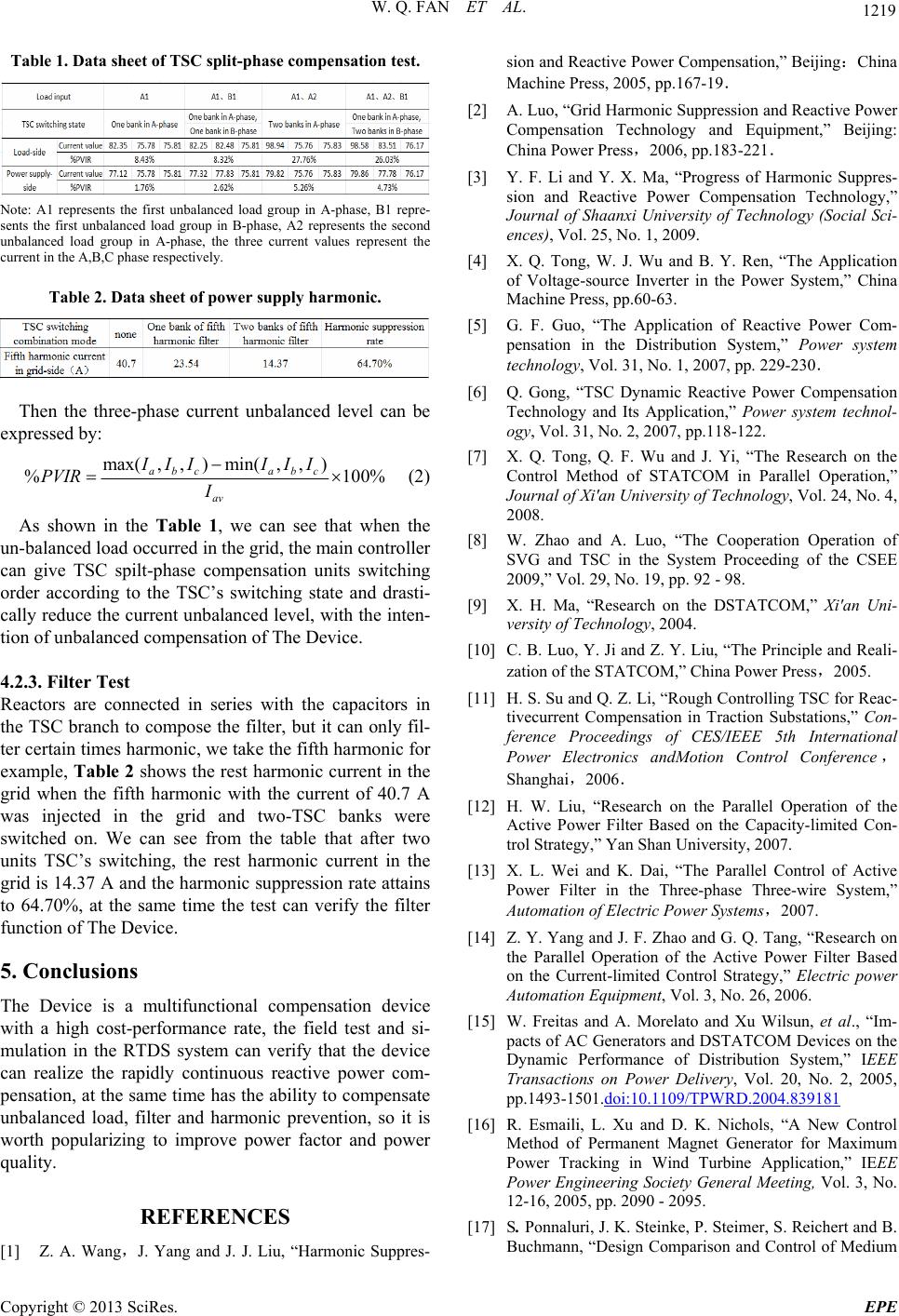
W. Q. FAN ET AL. 1219
Table 1. Data sheet of TSC split-phase compensation test.
Note: A1 represents the first unbalanced load group in A-phase, B1 repre-
sents the first unbalanced load group in B-phase, A2 represents the second
unbalanced load group in A-phase, the three current values represent the
current in the A,B,C phase respectively.
Table 2. Data sheet of power supply harmonic.
Then the three-phase current unbalanced level can be
expressed b y :
max( ,,) min( ,,)
%
abc abc
av
III III
PVIR I
100%
(2)
As shown in the Table 1, we can see that when the
un-balanced load occurred in the grid, the main controller
can give TSC spilt-phase compensation units switching
order according to the TSC’s switching state and drasti-
cally reduce the current unbalanced level, with th e inten-
tion of unbalanced compensation of The Device.
4.2.3. Fi lter Test
Reactors are connected in series with the capacitors in
the TSC branch to compose the filter, but it can only fil-
ter certain times harmonic, we take the fifth harmonic for
example, Table 2 shows the rest harmonic current in the
grid when the fifth harmonic with the current of 40.7 A
was injected in the grid and two-TSC banks were
switched on. We can see from the table that after two
units TSC’s switching, the rest harmonic current in the
grid is 14.37 A and the harmonic suppression rate attains
to 64.70%, at the same time the test can verify the filter
functio n o f The Device.
5. Conclusions
The Device is a multifunctional compensation device
with a high cost-performance rate, the field test and si-
mulation in the RTDS system can verify that the device
can realize the rapidly continuous reactive power com-
pensation, at the same time has the ability to co mpensate
unbalanced load, filter and harmonic prevention, so it is
worth popularizing to improve power factor and power
quality.
REFERENCES
[1] Z. A. Wang,J. Yang and J. J. Liu, “Harmonic Suppres-
sion and Reactive Power Compensation,” Beijing:China
Machine Press, 2005, pp.167-19.
[2] A. Luo, “Grid Harmonic Suppression and Reactive Power
Compensation Technology and Equipment,” Beijing:
China Power Press,2006, pp.183-221.
[3] Y. F. Li and Y. X. Ma, “Progress of Harmonic Suppres-
sion and Reactive Power Compensation Technology,”
Journal of Shaanxi University of Technology (Social Sci-
ences), Vol. 25, No. 1, 2009.
[4] X. Q. Tong, W. J. Wu and B. Y. Ren, “The Application
of Voltage-source Inverter in the Power System,” China
Machine Press, pp.60-63.
[5] G. F. Guo, “The Application of Reactive Power Com-
pensation in the Distribution System,” Power system
technology, Vol. 31, No. 1, 2007, pp. 229-230.
[6] Q. Gong, “TSC Dynamic Reactive Power Compensation
Technology and Its Application,” Power system technol-
ogy, Vol. 31, No. 2, 2007, pp.118-122.
[7] X. Q. Tong, Q. F. Wu and J. Yi, “The Research on the
Control Method of STATCOM in Parallel Operation,”
Journal of Xi'an University of Technology, Vol. 24, No. 4,
2008.
[8] W. Zhao and A. Luo, “The Cooperation Operation of
SVG and TSC in the System Proceeding of the CSEE
2009,” Vol. 29, No. 19, pp. 92 - 98.
[9] X. H. Ma, “Research on the DSTATCOM,” Xi'an Uni-
versity of Technology, 2004.
[10] C. B. Luo, Y. Ji and Z. Y. Liu, “The Principle and Reali-
zation of the STATCOM,” China Power Press,2005.
[11] H. S. Su and Q. Z. Li, “Rough Controlling TSC for Reac-
tivecurrent Compensation in Traction Substations,” Con-
ference Proceedings of CES/IEEE 5th International
Power Electronics andMotion Control Conference,
Shanghai,2006.
[12] H. W. Liu, “Research on the Parallel Operation of the
Active Power Filter Based on the Capacity-limited Con-
trol Strategy,” Yan Shan University, 2007.
[13] X. L. Wei and K. Dai, “The Parallel Control of Active
Power Filter in the Three-phase Three-wire System,”
Automation of Electric Power Syste ms,2007.
[14] Z. Y. Yang and J. F. Zhao and G. Q. Tang, “Research on
the Parallel Operation of the Active Power Filter Based
on the Current-limited Control Strategy,” Electric power
Automation Equipment, Vol. 3, No. 26, 2006.
[15] W. Freitas and A. Morelato and Xu Wilsun, et al., “Im-
pacts of AC Generators and DSTATCOM Devices on the
Dynamic Performance of Distribution System,” IEEE
Transactions on Power Delivery, Vol. 20, No. 2, 2005,
pp.1493-1501.doi:10.1109/TPWRD.2004.839181
[16] R. Esmaili, L. Xu and D. K. Nichols, “A New Control
Method of Permanent Magnet Generator for Maximum
Power Tracking in Wind Turbine Application,” IEEE
Power Engineering Society General Meeting, Vol. 3, No.
12-16, 2005, pp. 2090 - 2095.
[17] S. Ponnaluri, J. K. Steinke, P. Steimer, S. Reichert and B.
Buchmann, “Design Comparison and Control of Medium
Copyright © 2013 SciRes. EPE